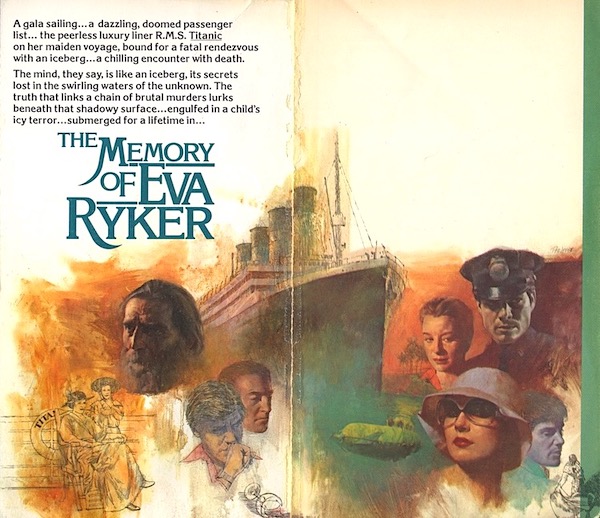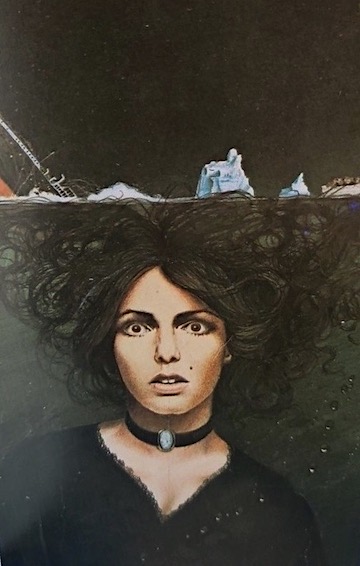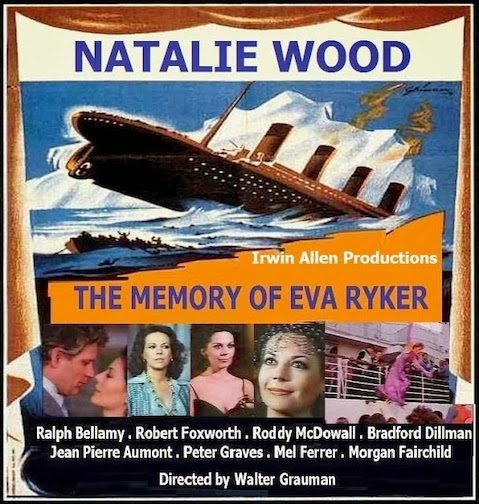'APRIL 14, 1912: The great TITANIC sinks after striking an iceberg. NOVEMBER 1941: In one of Hawaii's most sensational unsolved crimes, a
middle-aged couple is brutally slain. NOW: A multimillion-dollar salvage
operation works to raise the TITANIC... while a London couple schemes
to take the fortune they know is waiting in its rusty hulk. What links
these events? One woman, Eva Ryker---an aging heiress who survived the
TITANIC and spent a lifetime erasing a night of horrors from her
mind---has the answer. One man, journalist Norman Hall, is determined to
raise the truth of the monstrous plot hatched aboard the doomed
ship---a plot that has already taken seven lives---and whose solution
lied deep inside THE MEMORY OF EVA RYKER.'
IF ENTERTAINMENT is the measure of a novel, than Donald A. Stanwood's The Memory of Eva Ryker is the length, width and height of the TITANIC itself.
That being said, The Memory of Eva Ryker is not without its rough water. No novel, no matter how sea-worthy it may appear, is entirely safe from sinking. Find me a perfect novel and I can probably find someone who can punch an iceberg sized hole in it. Still, other than the final unmasking of Eva's repressed memory, the horror of which I found to be disturbingly gratuitous (though necessary to the story one might argue) and the abject brutalizing of two otherwise benign characters for no apparent reason that I could discern (it certainly didn't advance the plot), there's absolutely nothing else in the book that I thought was either weak or disappointing or dull. From my perspective, The Memory of Eva Ryker was grand reading on a grand scale. At some point in the future I know I'll be reading it again.
Dell published this paperback first edition in 1979.
 |
| CLICK TO ENLARGE |
Dell's cover and
stepback art were painted in oil and graphite by Fred
Pfeiffer (Roger Kastel also used this mixed media technique in almost the exact same way while producing for Pocket and Bantam). Pfeiffer was an extraordinarily skilled artist, who despite a limited time actually working in publishing, managed to produce an exceptional amount of high quality cover art. He entered the book business in the late
1960's, but within just a short time he had developed his painting style to
be among the very best that there was. In the early 1980's he left the business to try his luck in California, producing movie posters and whatever else he could find out there, but when he attempted to return to the fold in 1995 he suddenly and tragically passed away. Pfeiffer was only 55 years old.
As with most cover collages of this nature, I try to figure out who's who, but it's not
always as easy as it would seem. Obviously, the policeman is our main protagonist,
Norman Hall. However, the woman on his left I can't quite place (actually, there
are several to choose from), but the lady in the hat is almost certainly Eva Ryker. To her right is
the ship's steward. But the bearded man does not match the description of the 85-year-old patriarch, William E. Ryker--and yet, it must be him. To his right are the "blonde man," a significant character, and the
"hired" thug, another important character manipulating events. And finally, sketched in graphite on the far left, are Claire
and Eva Ryker, shown lounging onboard the Titanic during its fateful crossing.
The first US hardcover edition of The Memory of Eva Ryker was published by Coward, McCann & Geoghegan of New York, in 1978. The jacket art was produced by Norm Walker (my apology for not having a better image of it). Walker, in addition to his many covers for Coward, supplied jacket
art for Putnam throughout the 1970's and 1980's. He also created advertising ephemera and cover
art for magazines such as Vertex and The Twilight Zone.
Below is the SYNOPSIS from the Coward edition--but reader take heed; if you haven't experienced the novel yet this description may provide too much SPOILER information for your own good:
'An eccentric billionaire, a bestselling author, a beautiful,
self-destructive woman: three lives linked by the tragic sinking of the TITANIC---and the fragile memories of a ten-year-old girl. April 11, 1912---The gala sailing out of Southampton of White Star Line's peerless luxury liner, R.M.S. TITANIC. Among the dazzling, doomed names on the passenger list for this, the Titanic's
maiden voyage, is Clair Austin Ryker, lovely and dissolute wife of
billionaire industrialist William Ryker. Clair is returning to her
husband from a round of expensive dissipation in the fashionable spas of
Europe with her ten-year-old daughter, Eva. Also on board, Jason and
Lisa Eddington, a young couple whose fresh beauty and sheer magnetism
even Clair Ryker's jaded sensibilities cannot fail to feel. And deep in
the liner's hold a crate labeled RYKER INDUSTRIES that carries important
cargo. All are bound for the Titanic's fatal midnight rendezvous of April 14th with the iceberg that will cost the lives of 1,490 of the 2,201 men and women aboard. November 30, 1941---Honolulu,
Hawaii, twenty-nine years later and six thousand miles distant, the
apparent accidental death of tourist Albert Klein and the brutal murder
of his wife confound the promising career of a young rookie cop. For the
rest of his days, even when he has become securely established as a
best-selling author, Norman Hall will never be able to erase from his
consciousness the grisly sight of the dismembered body of Martha Klein.
What possible link can connect the macro-- to the micro-tragedy? Two
slender strips of tape---one a faded film capturing the sunny pleasures
of a shipboard party; the other, a terrifying tape of a child's shocked
voice describing a night of darkest infamy and moral outrage. It is
Norman Hall's plum assignment, fifty years after the liner's sinking, to
cover for WORLD magazine William Ryker's multimillion-dollar salvage expedition to recover the lost riches of the TITANIC.
It is Norman Hall's dangerous obsession to understand the billionaire
recluse's motives and to exorcise his own demons by uncovering the truth
that lies locked in the memory of Eva Ryker.'
The first British hardcover edition was published in 1978 by Hamish Hamilton. The jacket art, with its glittering diamond acting as a mirror of the story, was produced by the prolific and oft-celebrated, Agatha Christie artist and designer Tom Adams (2926-2019). You may recall Adams from his earlier, and somewhat famous, trompe l‘oeil-style cover art on John Fowles' The Collector.
The first British paperback edition was published by Corgi in 1979. The
cover has a die-cast keyhole shaped like a porthole, revealing a glimpse
of the *stepback art just underneath; a girl submerged in water, with the Titanic, the iceberg and a lifeboat all placed above her (*note: my stepback is distorted and has been slightly cropped). The artist who created it is not known (although Tom Adams has been suggested) and
copies of this paperback edition are almost impossible to come by here in
the States.
DONALD A. STANWOOD was born in Glendale, California, in 1949. He was a student at California State University at Fullerton when he started writing The Memory of Eva Ryker. Eight years later he finished it. Stanwood published only one other novel after that, The Seventh Royale (featured just below).

The Seventh Royale is a serpentine, quasi political crime thriller,
with historic 1930's overtones. The so-called "Car of Kings," a Bugatti
Type 41 "Royale," figures
heavily into its plot. Only six were supposedly ever built, hence the
mythical and clearly coveted 'seventh.' Publisher's Weekly called the
novel "engrossing, moving and heavily atmospheric." Author T. Jefferson Parker said of it: "Like the car it involves, The Seventh Royale starts fast and accelerates with a velocity that could cause whiplash." Because of quotes like these, and how much I thoroughly enjoyed reading TMOER, this book is now on
the top of my TBR pile.
The publishing dates for The Seventh Royale, as seen descending above, are as follows:
Atheneum (US, hardcover, 1987, jacket art by Paul Bacon).
Bodley, Head (UK, hardcover, 1987, jacket art or photo not credited).
Dell (US, paperback, 1988, cover art or photo not credited).
Arrow (UK, paperback, 1988, image not shown).
*Once again a SPOILER alert if you read the Atheneum synopsis.
The publishing dates for The Seventh Royale, as seen descending above, are as follows:
Atheneum (US, hardcover, 1987, jacket art by Paul Bacon).
Bodley, Head (UK, hardcover, 1987, jacket art or photo not credited).
Dell (US, paperback, 1988, cover art or photo not credited).
Arrow (UK, paperback, 1988, image not shown).
*Once again a SPOILER alert if you read the Atheneum synopsis.
ATHENEUM edition (*again, a SPOILER alert if you choose to read the following jacket synopsis): 'In the first days of Rommel's retreat, American G.I. Alan Escher rescues escaping war prisoner and former Grand Prix champion Elio Cezale on an African road. Cezale credits Escher with saving his life, and his gratitude blossoms into profound friendship. After the war, the men are reunited at an obscure French farmhouse where, now safe from Nazi Plunderers, Cezale's Bugatti race car is brought from the floorboards and reassembled. it is a time of celebration--and also provides the first hint of a baffling puzzle. For, twenty-six years later, Escher is summoned to Reno, Nevada, and to Cezale's side. But this is to be no casual reunion of old friends. Escher finds Cezale distracted, even paranoid, the result, perhaps, of the long, clandestine road trips he is making each night, his car carefully wiped clean and the odometer rolled back after every return. Suddenly, Cezale is dead, the intentional victim of a hit-and-run driver. And when the family convenes to read his will, they are stunned further to learn that Cezale has left them broke, his fortune secretly withdrawn by him during the final weeks of his life. Why? Escher's only clue lies in his own bequest, the key to a Zurich safe-deposit box. What he finds there propels him into the seductive--and seductively dangerous--world of vintage automobiles. It is a world where collectors go to any length to possess the best of them--specifically, the Bugatti Type 41 "Royale," the costliest car of its day, appealing to a clientele so rarefied that only six were ever built. Escher's search for Cezale's killer, and for the Royale he comes to understand will unlock the puzzle, takes him from Reno to Salt Lake City, where he encounters the feuding members of a polygamous Mormon family, then to Paris, where a mysterious veteran of Berlin's glittering prewar film industry sets Escher on a collision course with Cezale's past--a past that reaches into the life of Adolf Hitler and his inner circle. The trail of clues, first blazed long ago in a wartime world, ultimately leads Escher to a small Colorado cabin, home these many dark years of a seventh, and last, "Royale"; and it is there that Escher discovers the final and most terrifying secret of them all.'
DELL edition: 'The winds of war brought Italian race car driver Elio Cezale and American movie maker Alan Escher face to face on the North African desert. An obsession would keep them together across four decades and three continents. For the world believed that only six Bugatti Royales---the most fabulous and expensive car ever built---existed. But somewhere there was a seventh... and finding it would lead a desperate man and a passionate woman back into the decadent center of Hitler's most intimate circle and forward into a vortex of sex, betrayal and death.'
After the success of both novels, Stanwood, allegedly, became an editor-in-chief at Oxmoor House. Oxmoor publishes books about cooking, crafts, holiday decorating, gardening and home-improvement, while also representing books for Sunset Magazine. Rumor has it that a third novel was begun by Stanwood, but apparently never finished.
* * * * *
IN 1980, Irwin Allen, Warner Bros and CBS produced a three-hour, Made-for-TV movie of Stanwood's novel. The Memory of Eva Ryker aired on May 7th of that year, starring, among others, Natalie
Wood, Ralph Bellamy, Robert Foxworth, Roddy McDowall and Morgan
Fairchild. This was Natalie Wood's last film before her tragic drowning death in 1981 off the
coast of Catalina Island (strangely enough, Wood's had to act out a drowning scene in the film). The film was directed by Walter Grauman and
the teleplay was written by Laurence Heath. One significant change in
the movie from the book was the doomed ship became the LUSITANIA and not the Titanic. My guess is that the producers must have felt that torpedoes are way more thrilling than
icebergs.
 |
| CLICK TO ENLARGE |
I've not had the pleasure, or displeasure, of seeing this
movie in its entirety, but a short trailer and a clip or two can be
viewed freely on youtube. To my knowledge, it has never been officially
released on DVD.
HAPPY SAILING !
[© September, 2021, Jeffersen]













No comments:
Post a Comment